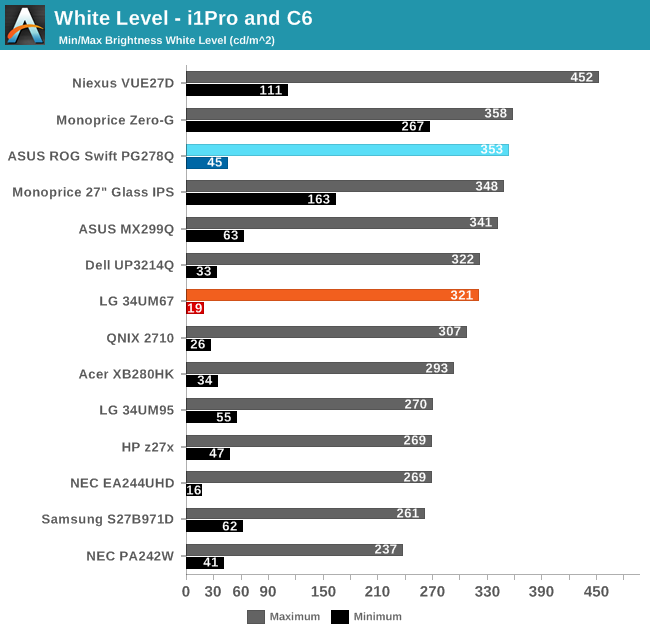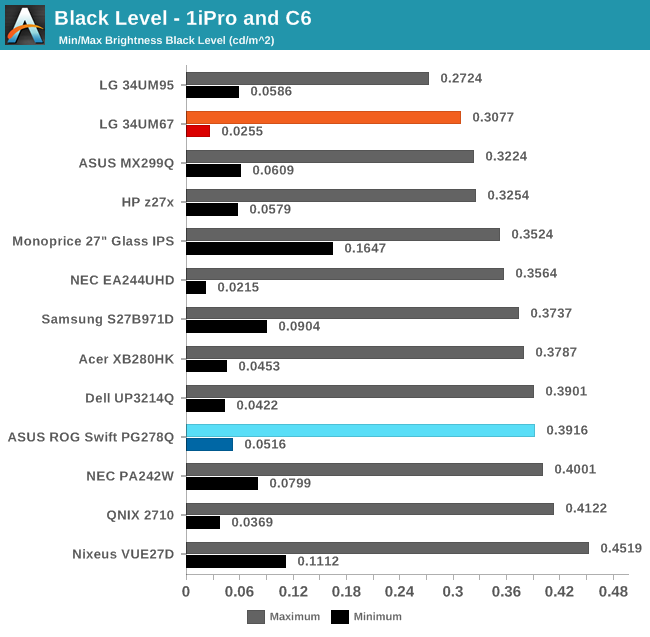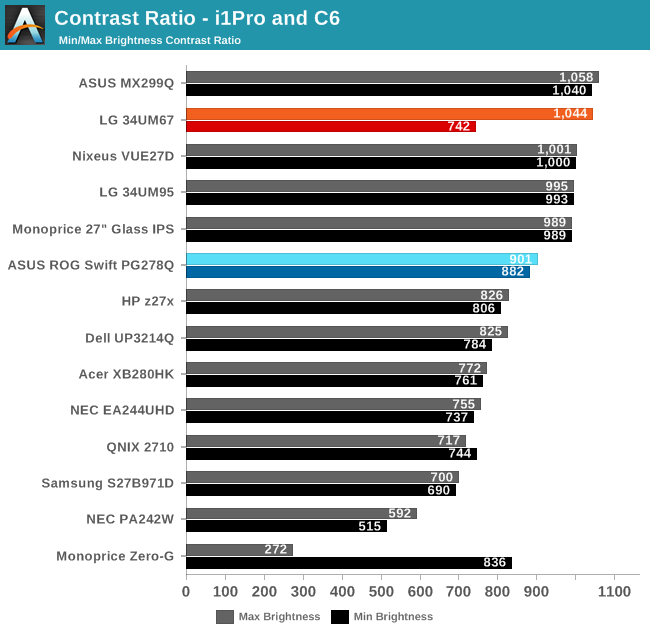LG 34UM67: UltraWide FreeSync Review
by Jarred Walton on March 31, 2015 3:00 PM ESTLG 34UM67 Brightness and Contrast
Moving on from the FreeSync discussion, we still need to see how the LG 34UM67 fares as a display. We’ve run our usual assessments to look at brightness, contrast, color accuracy, and uniformity. We’ll start with the brightness results. The LG FreeSync 34UM67 is in orange/red while we've highlighted the ASUS PG278Q in cyan/blue.

Set to maximum brightness with the default (50/50/50) RGB values, the 34UM67 can output 306 nits, which is just above the rated 300 nits. However, you can increase the output a bit more by maxing out the RGB values at 100, which gives us the above result of 321 cd/m2. This is plenty bright for most people, and more than I would normally need (outside of situations where the display needs to overcome reflections and lights during the day.) Setting the brightness to the minimum level with 50% RGB drops the display to 52 cd/m2, which is perhaps a bit too bright, but if you tweak RGB settings you can get as low as 19 cd/m2. That can work even in very dark rooms, so LG has covered all the necessary output range.

Black levels are okay but nothing amazing. At the maximum backlight (with the OSD Black Stabilizer set to 0 – increasing it will increase black levels somewhat, ostensibly to help you see dark areas in games better), we measured 0.3077 cd/m2. Going to the minimum backlight level this falls down to 0.0255 cd/m2. Interestingly, LG doesn’t appear to be using any form of dynamic contrast, so whether we test with a full screen color or 50% APL patterns makes no difference. That’s a good thing if you’re wondering, as dynamic contrast often ends up being more of a distraction than a benefit (IMO).

The resulting contrast ratios range from just over 1000:1 to closer to 750:1, but the contrast ratio stays pretty consistent until the very lowest brightness settings. Also note that our i1 Pro meter isn’t the most accurate sensor for black levels, so that might contribute to some of the difference. Overall, the contrast ratio is good but not exceptional.










96 Comments
View All Comments
mobutu - Wednesday, April 1, 2015 - link
There's one really good 144Hz IPS panel/monitor: http://www.tftcentral.co.uk/reviews/acer_xb270hu.h...3DVagabond - Wednesday, April 1, 2015 - link
It's not an AMD display. It's LG. AMD only makes the cards that can do dynamic refresh rates with the DP1.2a standard. Whatever the specs or features are for the panel are at the monitor manufacturers discretion.Murloc - Wednesday, April 1, 2015 - link
that's one advantage of G-Sync: more control on monitor features since they can just refuse to license the board and it protects the brand by giving it a premium feel (putting the horrible RMA rates I heard about the swift aside), and people fall for it.medi01 - Thursday, October 22, 2015 - link
There is no such advantage, 1.2a is a standard, AMD FreeSync is a sticker which they can decide to give or not.Ubercake - Wednesday, April 1, 2015 - link
I agree. This implementation of adaptive sync is pretty bad. Frame rates in games like Battlefield 4 are often above 90 while playing and then can drop into the 50s at different points. With most games the frame rates are all over the place based on GPU demand and don't fit into this 27Hz/27fps range.dragonsqrrl - Wednesday, April 1, 2015 - link
As mobutu said Acer currently has a 144Hz IPS G-Sync monitor on the market, and to top it all off it's 27" 1440p. Linus recently did a great video review of the XB270HU:https://www.youtube.com/watch?v=_LTHr96NueA
blanarahul - Tuesday, March 31, 2015 - link
*sniff* *sniff* Nobody cares about the high contrast ratio VA panels.jjj - Tuesday, March 31, 2015 - link
At just 1080p feels like a waste to go there. Even 1440p doesn't feel like enough if you are gonna invest this much in a new screen.Anyway, it might be wise to include screen dimensions and screen area in the specs. With such huge differences in AR, the diagonal is misleading. Hell, i would even chart price per square cm but i don't expect you to do that. A 34 inch 16:10 screen would be almost 25% bigger than this one, or a 30inch 16;10 is almost the same area. In a better world regulators would force retailers to properly display screen dimensions, 99.9% of consumers don't realize the differences in size that come with AR.
xthetenth - Tuesday, March 31, 2015 - link
3440x1440 is really worth it because it's the best resolution you can get for working without messing around with scaling (and frankly it's better than the ones you'd want to use with scaling in most regards for functionality)jjj - Tuesday, March 31, 2015 - link
At 650$ it's a 5 years or more purchase not 1-2 years. And that's mostly 4k territory.Buying a 27inch 1080p IPS at 200$ on an easy to find deal is ok for 1-2 years of usage but this is a lot more. 1440p is much better than 1080p ofc but it also costs a lot more and you end up in a similar situation.